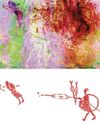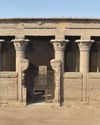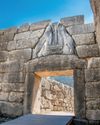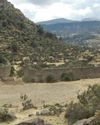The Olmec city of Tres Zapotes may have owed its longevity to a new form of government.

On a sweltering day in 1862 at the foot of the Tuxtla Mountains in the Mexican state of Veracruz, a farm worker was clearing a cornfield when he hit something hard and smooth lodged in the earth. He thought it was the rounded base of an iron cauldron buried upside down, and, it being the 1860s, he reported the find to the owner of the hacienda where he worked. The farmworker’s boss told him to dig up the cauldron immediately and bring it to him. As the farm worker labored to uncover the object, he realized he had found not a large iron bowl, but a gargantuan stone sculpture with a pair of glaring eyes, a broad nose, and a down turned mouth. What had appeared to be the base of a cauldron was actually the top of a helmet worn by the glowering figure. What the farm worker had unearthed was a colossal Olmec head, one of the first clues to the existence of that ancient culture.
Over the next century and a half, archaeologists would uncover many more of these heads along the Mexican Gulf Coast and discover the ancient cities where they were carved. The site of that first fateful discovery became known as Tres Zapotes, after a type of fruit tree common in the area. Along with the sites of San Lorenzo and La Venta, Tres Zapotes was one of the great capitals of the Olmec culture, which emerged by 1200 b.c. as one of the first societies in Mesoamerica organized into a complex social and political hierarchy.
This story is from the March/April 2017 edition of Archaeology.
Start your 7-day Magzter GOLD free trial to access thousands of curated premium stories, and 8,500+ magazines and newspapers.
Already a subscriber ? Sign In
This story is from the March/April 2017 edition of Archaeology.
Start your 7-day Magzter GOLD free trial to access thousands of curated premium stories, and 8,500+ magazines and newspapers.
Already a subscriber? Sign In

A Very Close Encounter
New research has shown that human figures painted in red on a rock art panel in central Montana depict individuals engaged in a life-or-death encounter during an especially fraught historical moment.

A Sword for the Ages
A zigzag pattern, now tinged with the green-blue patina of oxidized metal, adorns the octagonal hilt of a rare sword dating to the Middle Bronze Age in Germany (1600-1200 B.C.) that was recently excavated in the Bavarian town of Nördlingen.

Ancient Egyptian Astrology
For centuries, layers of soot have coated the ceilings and columns in the entrance hall of Egypt's Temple of Esna. Now, an Egyptian-German team of researchers, led by Hisham El-Leithy of the Egyptian Ministry of Tourism and Antiquities and Christian Leitz of the University of Tübingen, is restoring the temple's vibrant painted reliefs to their original brilliance.

BRONZE AGE POWER PLAYERS
How Hittite kings forged diplomatic ties with a shadowy Greek city-state

RITES OF REBELLION
Archaeologists unearth evidence of a 500-year-old resistance movement high in the Andes

Secrets of Egypt's Golden Boy
CT scans offer researchers a virtual look deep inside a mummy's coffin

When Lions Were King
Across the ancient world, people adopted the big cats as sacred symbols of power and protection

UKRAINE'S LOST CAPITAL
In 1708, Peter the Great destroyed Baturyn, a bastion of Cossack independence and culture

LAPAKAHI VILLAGE, HAWAII
Standing beside a cove on the northwest coast of the island of Hawaii, the fishing village of Lapakahi, which is surrounded by black lava stone walls, was once home to generations of fishers and farmers known throughout the archipelago for their mastery of la'au lapa'au, or the practice of traditional Hawaiian medicine. \"

A MORE COMFORTABLE RIDE
Although the date is much debated, most scholars believe people 5,000 years ago. For thousands of years after that, they did so without saddles. \"In comparison with horse riding, the development of saddles began relatively late, when riders began to care more about comfort and safety in addition to the horse's health,\" says University of Zurich archaeologist Patrick Wertmann.